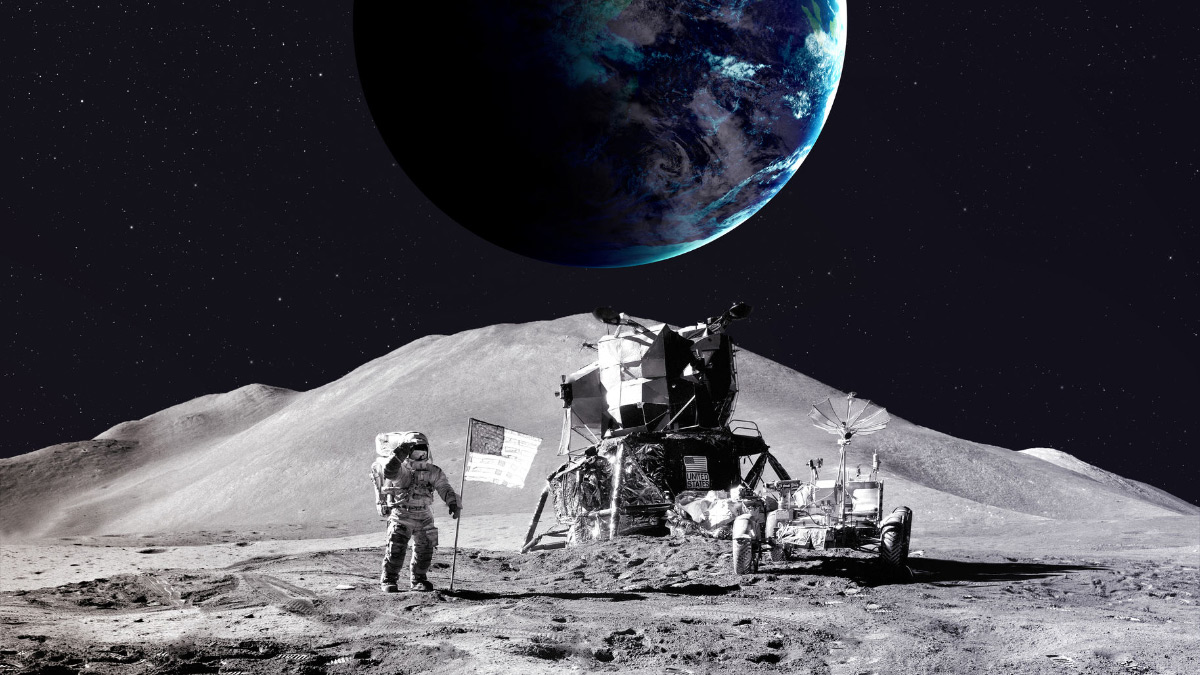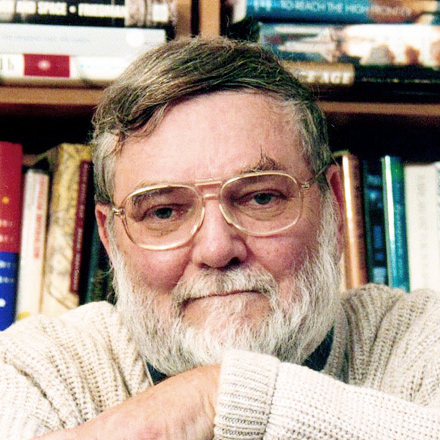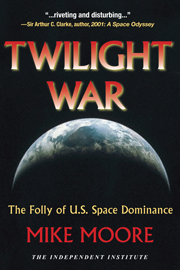Fifty years ago this Sunday, two American astronauts walked on the moon, albeit for only a couple of hours. Pioneers, surely. They were the first humans to escape Earth’s “gravity well” and stroll on the surface of another celestial body. And on that body, they planted an American flag.
It was not a flag of ownership; according to international law, no nation can claim the moon. Rather, the flag represented national pride. A celebration of American scientific, technical and industrial genius; of setting an extremely difficult goal—to walk on the moon before the decade was up—and then achieving that goal.
But the mission also represented something more profound than national pride. Michael Collins, commander of the mother ship, Columbia, remained in orbit while Buzz Aldrin and Neil Armstrong climbed down from the goofy-looking lander named Eagle for their moon walk. As Armstrong planted his boot on the powdery surface, he declared: “That’s one small step for man . . . one giant leap for mankind.”
Evocative words that swept the world; inspiring words that set the imagination afire. The Apollo missions of course defined American-bred expertise. But Armstrong’s words suggested something more; that all of us, everyone on the globe, had made a mind-boggling breakthrough, and that humanity’s next stop would be Mars. And after that—albeit in the eerily far distant future—the stars.
And yet, after five more manned Apollo missions, no human has set boots on the moon since December 1972, much less Mars. Why is that? The answer: perhaps an outbreak of realism. Sending men and women back to the moon today would be terribly expensive ... and perhaps pointless from a scientific point of view.
As for going to Mars, there has been much dreamy talk by several nations, including the United States, and considerable preliminary planning. (Which includes valiant efforts at the University of Arizona’s Biosphere Two in Oro Valley to figure out how to make a Mars colony self-sustaining regarding.)
Despite the planning, a manned Mars expedition is not yet on anyone’s front burner. After all, humankind has been successively and economically exploring our solar system with unmanned robotic vehicles since the first two Voyager missions launched in 1977. And these thousand or so robotic missions have sent back mountains of scientific data, including reams of information about Mars. And without risk to human life.
To be sure, the Trump administration favors a manned moon mission by 2024. (Any future manned Mars mission presumably would be launched from lunar base.) But a moon/Mars mission could be frightfully expensive, even by today’s bloated standards. Funding for the venture would be highly uncertain.
Yes, the Apollo moon landings were world-class events in human history; they were something our nation can be justly proud of. Further, all of the astronauts were true heroes; it takes enormous courage for anyone to permit controlled explosions—in a multi-stage rocket taller than a football field is long—to hurl them into space.
And yet, the Apollo program may have been a one-off. The enthusiasm for sending men and women to the moon and beyond has waxed and waned over the decades. Perhaps that is because the Apollo program was conceived as a political propaganda project as much as a scientific effort, an artifact of the Cold War.
Think back to the late 1950s and the Eisenhower presidency. Ike was not the genial, grandfatherly, golf-playing type we saw now and then on TV. He was tough, decisive and brutally analytical when it came to foreign affairs. He understood that Soviet leaders feared the United States, and that the fear had a solid basis.
Though the United States, Britain and the Soviet Union were allies during the war with Nazi Germany, and though the Soviet Union had borne the terrible brunt of the European war—27 million war-related deaths in the Soviet Union is the official estimate—we did not tell Stalin of the war-time American-British atom bomb project.
That’s understandable. Stalin had earlier proved himself to be a murderous and untrustworthy chap. Nonetheless, his post-war fear of the United States was reasonable. America, he said, would use the atom bomb to intimidate Moscow, which sought to consolidate—often with violence—its newly acquired holdings in Eastern and Central Europe and to expand its influence in the Mediterranean, the Middle East and the Far East. “Hiroshima has shaken the whole world,” Stalin said. “The balance has been destroyed.”
Stalin was right; the United States held all the aces. We had the bomb, while the war had converted much of the Soviet industrial heartland to rubble. A few high-level military officers in the United States, as well as influential citizens, sought to milk that advantage by privately—and sometimes publicly—arguing that the United States should preemptively attack the Soviet Union before the Russkies had enough atom bombs to attack us. That is, the United States should launch a Pearl Harbor-style attack on its former ally.
The first major public exploration of the issue came in the July 5 and August 16, 1948, issues of Life magazine, then arguably the most influential publication in the United States. The author: Carl Spaatz, the recently retired chief of staff of the Air Force. At present, said Spaatz, the Soviet Union was no match for the United States, which was still the sole atomic power.
But that would change. The Russians, he said, were “working feverishly to break the American monopoly.” As early as 1952, the Russians might have their own atomic bombs—and the bombers that could deliver them. (They tested their first atom bomb in the summer of 1949.)
Spaatz did not publicly advocate an American surprise attack on the Soviet Union. But a host of high-level generals and admirals, as well as influential civilians did. First Harry S Truman and then Dwight D. Eisenhower shot this talk down, even firing some of the most ardent proponents of an American Pearl Harbor. (Gen. Curtis LeMay, who eventually became chief of staff of the Air Force, never deviated from his advocacy of launching a preemptive attack.)
The Cold War featured the two great powers jockeying for dominance, building nuclear arsenals eventually mounting into the tens of thousands of weapons, ranging in size from dam busters to city killers. Then came the “cataclysm” of October 1957, when the Soviets put a primitive satellite into orbital space. Its only mission: sending out beeps designed to be heard around the world.
America went nuts. An inattentive President Eisenhower had put us at risk, went the common argument. If the Russkies could build a satellite, what would stop them from dropping a nuclear bomb on the White House?
As we neared the 1960 presidential election, leading Democrats became ever more shrill in insisting that the Soviets were far ahead of the United States in long-range bombers and then in intercontinental ballistic missiles. Presidential hopefuls—Stuart Symington of Missouri; Lyndon Johnson of Texas; and Jack Kennedy led the Missile Gap charge.
We now know the bomber and missile-gap rhetoric was nonsense. Eisenhower, who believed in facts rather than bombast, had launched the ultra-secret U-2 spy plane program in 1956 to collect hard data on actual Soviet capabilities; it was later followed by a spy satellite program, Project CORONA.
The first successful CORONA satellite passed over the Soviet Union seven times and provided more photographic coverage of that closed nation than all 23 successful U-2 flights combined. The CORONA program ended in May 1972, after finding Soviet medium-range, intermediate-range and long-range missile launch sites; photographing all classes of Soviet submarines and their bases; tracking the Soviet surface fleet; identifying and counting Soviet fighters and bombers; revealing the presence of Soviet missiles in Egypt; documenting Soviet assistance to China’s nuclear program; and uncovering the Soviet antiballistic missile program.
All subsequent national security satellites trace their lineage to CORONA. On March 16, 1967, President Lyndon B. Johnson said:
“I wouldn’t want to be quoted on this, but we’ve spent 35 or 40 billion dollars on the space program. And if nothing else had come out of it except the knowledge we’ve gained from space photography, it would be worth ten times what the whole program has cost.
“Because tonight we know how many missiles the enemy has and, it turned out, our guesses were way off. We were doing things we didn’t need to do. We were building things we didn’t need to build. We were harboring fears we didn’t need to harbor. Because of satellites, I know how many missiles the enemy has.”
The Apollo Program was a daring gambit in the Cold War. President Kennedy, despite his rhetorical brilliance, was far outclassed by the canny Nikita Khrushchev when it came to U.S.-Soviet relations. Kennedy’s Bay of Pigs fiasco and his general ineptness in dealing with Khrushchev over Berlin, had greatly chastened him. Meanwhile, millions of men and women throughout the world had come to believe that the Soviet Union, with its early success in placing men in earth orbit, was ahead of the United States in scientific expertise.
Kennedy sought to regain the initiative with a new goal: sending men to the moon and bringing them home safely before the decade ended. His “moon” speech, delivered at Rice University on Sept. 12, 1962, was a rhetorical masterpiece.
“We choose to go to the moon,” he said, “because that goal will serve to organize and measure the best of our energies and skills, because that challenge is one that we are willing to accept, one we are unwilling to postpone, and one which we intend to win . . . .”
He was right, of course. The Apollo program restored American prestige throughout the world. Nothing wrong with that; it was an extraordinary achievement. But was it worth the cost—perhaps $200 billion in today’s dollars? Despite its scientific brilliance, its human drama, Apollo is, in a sense, a relic of the Cold War. The true importance of the Apollo missions is that we won the moon “race.”
Today, we now understand that e earthlings have always had a space ship: the “pale blue dot” that the late Carl Sagan—astronomer, educator, philosopher and global treasure—described so elegantly twenty-five years ago.
“Look again at that dot,” he wrote of a picture of our planet floating in a sea of stars. “That’s here. That’s home. That’s us. On it everyone you love, everyone you know, everyone you ever heard of, every human being who ever was, lived out their lives.
“The aggregate of our joy and suffering, thousands of confident religions, ideologies, and economic doctrines, every hunter and forager, every hero and coward, every creator and destroyer of civilization, every king and peasant, every young couple in love, every mother and father, hopeful child, inventor and explorer, every teacher of morals, every corrupt politician, every ‘superstar,’ every ‘supreme leader,’ every saint and sinner in the history of our species lived there—on a mote of dust suspended in a sunbeam.”
I don’t wish to mislead you. Sagan was an enthusiastic proponent of human space travel. In a sense, he believed that human destiny lay well beyond earth. He was an avid advocate of the idea that we humans have a built-in need to explore the universe. To deny the need for human exploration, for adventure, was to deny, in a profound sense, our humanity. And yet, there is this sobering reality: When Apollo 11 reached the moon, our planet had about 3.7 billion people. Now there are thought to be somewhere around 7.5 billion. All of whom need to be clothed, fed, and kept healthy.
Meanwhile, the climate is warming; local weather patterns are in flux; glaciers are melting; deep ocean currents are becoming erratic; fresh water supplies may no longer supply human needs in major parts of the world; desertification is rampant; and hundreds of millions of people are malnourished or starving.
Spaceship Earth—Sagan’s pale blue dot—is in deep trouble. Should we spend huge sums of money to return to the moon or go to Mars when so much needs to be done to make Spaceship Earth serve the needs of all? That’s a profound question.
Yes, let us salute the audacity and courage and competence inherent in the Apollo program. But it is history; tending to Spaceship Earth is now our immediate and permanent mission.









